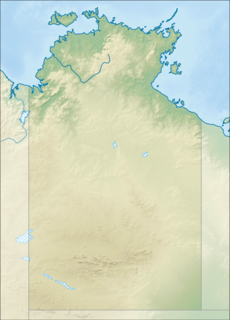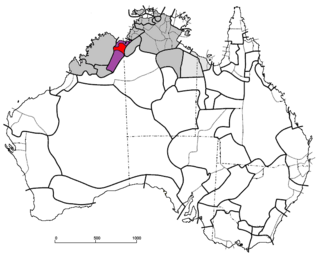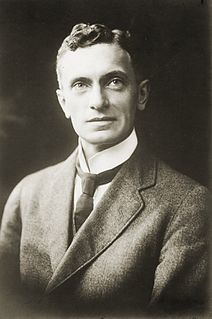Country
Gadjerong lands encompased 800 square miles (2,100 km2) in Norman Tindale's reckoning. They ran westwards along the rich ecosystems of mangrove flat, waterholes, creeks and waterfalls along the coastal area from the mouth of the Fitzmaurice River as far as point where the Keep River flows out into the Joseph Bonaparte Gulf. Their inland extension, taking in also at Legune, went as far as the vicinity of Border Springs. They also frequented the offshore area of Quoin Island, and further north, Clump Island, and those off the mouth of Keyling Inlet.

Norman Barnett Tindale AO was an Australian anthropologist, archaeologist, entomologist and ethnologist.

The Fitzmaurice River is a river in Australia's Northern Territory.

The Keep River is a river, located in the Victoria Bonaparte bioregion of Western Australia and the Northern Territory in Australia.
This page is based on this
Wikipedia article Text is available under the
CC BY-SA 4.0 license; additional terms may apply.
Images, videos and audio are available under their respective licenses.
Gija, also spelt Gidja and Kija, alternatively known as the Lungga, refers to Aboriginal Australians from the East Kimberley area of Western Australia, about 200 km south of Kununurra. In the late 19th century pastoralists were fiercely resisted by Gija people, many of whom now live around localities such as Halls Creek and Warmun.
The Mangala are an Indigenous Australian people of Western Australia. The Mangala people traditionally lived in the north-western area of the Great Sandy Desert, west of the Karajarri people, east of the Walmajarri, with the Juwaliny and Yulparija to the south. At present many Mangala people live in Jarlmadangah and Bidyadanga.
The Brabiralung were an Indigenous Australian people, one of the five tribes of Gippsland, in the state of Victoria, Australia, and belonged to a wider regional grouping known as the Kurnai.
The Miriwung are an indigenous Australian people of the Kimberley region of northern Western Australia.
The Djaui, also commonly called the Jawi, are an indigenous Australian people of the Kimberley coast of Western Australia.
The Yawijibaya, also known as the Jaudjibaia, were an indigenous Australian people of the Kimberley region of northern Western Australia.
The Umiida, also written Umede, were an indigenous Australian people of the Kimberley region of north Western Australia.
The Gooniyandi, also known as the Konejandi, are an indigenous Australian people of Western Australia.
The Wadjiginy, also referred to historically as the Wogait, are an indigenous Australian people of the Northern Territory.
The Arnga are an indigenous Australian people of the northern Kimberley region of Western Australia.
The Yeidji, otherwise commonly known as the Gwini, are an indigenous Australian people of the Kimberley area of Western Australia.
The Unggarranggu, also traditionally transcribed as Ongkarango, are an indigenous Australian people of Western Australia.
The Wurla, also written Ola, or Waladjangarri, are an indigenous Australian people of the Kimberley region of Western Australia
The Doolboong, also known as Duulngari, were an indigenous Australian people of the Northern Territory and northeast Western Australia.
The Ngalea or Ngalia were an indigenous Australian people of the Western Desert cultural bloc resident in land extending from Western Australia to the west of South Australia. They are not to be confused with the Ngalia of the Northern Territory.
The Ngombal, also known as the Ngumbarl, are an indigenous Australian people of Western Australia.
The Gudanji, otherwise known as the Kotandji or Ngandji, are an indigenous Australian people of the Northern Territory.
The Muringura, or Murrinh-Kura, were an indigenous Australian people of the Northern Territory.
The Wandjira were an indigenous Australian people of the Northern Territory.







